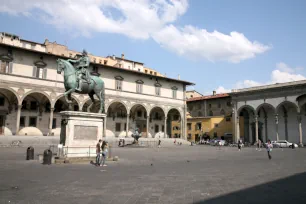The Piazza della Santissima Annunziata is one of the most beautiful squares in Florence. Arcades border the pedestrianised square on three sides. The central arcade forms the portico of the Santissima Annunziata church, which gave the square its name.



At the center of the square stands a large bronze equestrian statue of Ferdinando I de’ Medici. It was created by Giambologna, a Flemish sculptor who had moved to Italy in 1550 where he became known for his mannerist sculptures. After Giambologna died in 1608, the sculpture was completed by his student Pietro Tacca. The latter is also responsible for the two intriguing fountains on the square, decorated with figures of grotesque mythical creatures. They are known as the Fontane dei mostri marini (Sea monster fountains).

Santissima Annunziata
The north side of the square is framed by the Santissima Annunziata church, a parish church founded in 1250 by the Servite order. The current building was constructed in the fifteenth century. The portico was added later, in 1601, and mimics the design of Brunelleschi’s portico of the Spedale degli Innocenti on the east side of the square.
Inside are nine chapels, the middle of which was designed by Giambologna for his own tomb. The church is lavishly decorated with frescoes, but most people come to see a painting that was started by a monk in 1252 and supposedly finished by an angel, the cause of a still ongoing veneration of the painting. The artwork depicts the Annunciation (Annunziata in Italian), hence the name of the church.

Spedale degli Innocenti
The Spedale degli Innocenti – Europe’s oldest orphanage – flanks the east side of the square. The orphanage opened in 1445 and allowed women who had birthed unwanted children to leave them here anonymously by placing them on a circular stone. After they rang a bell, the stone was rotated 180 degrees, taking the baby inside the orphanage.
The arcaded portico was designed in 1419 by Brunelleschi and was the first classical loggia in the city. It would later serve as an example for other Renaissance architects. The façade is decorated with ceramic glazed medallions depicting swaddled babies. They were created by Andrea della Robbia, a Florentine artist who specialized in ceramic reliefs.
The building is home to a small museum with a collection of paintings, most of them depicting the Madonna with child. The most notable painting is the Adoration of the Wise Men by Domenico Ghirlandaio where the nativity scene contrasts starkly with the background depiction of the massacre of the innocents. The orphanage, which is officially known as the Ospedale degli Innocenti or Hospital of the Innocents, is named after this biblical event.

